Swing bridge
- For other uses, see Swing Bridge (disambiguation)
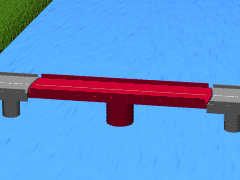 |
|
| Ancestor | Truss bridge, cantilever bridge |
|---|---|
| Related | Other moving types: Bascule bridge, drawbridge, jetway, lift bridge, tilt bridge |
| Descendant | Gate-swing bridge - see Puente de la Mujer |
| Carries | Automobile, truck, light rail, heavy rail |
| Span range | Short |
| Material | Steel |
| Movable | Yes |
| Design effort | Medium |
| Falsework required | No |
A swing bridge is a movable bridge that has as its primary structural support a vertical locating pin and support ring, usually at or near to its center of gravity, about which the turning span can then pivot horizontally as shown in the animated illustration below. Small swing bridges as found over canals may be pivoted only at one end, opening as would a gate, but require substantial underground structure to support the pivot.
In its closed position, a swing bridge carrying a road over a river or canal, for example, allows road traffic to cross. When a water vessel needs to pass the bridge, road traffic is stopped (usually by traffic signals and barriers), and then motors rotate the bridge approximately 90 degrees horizontally about its pivot point.
Contents |
Advantages
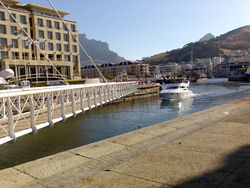
- As this type requires no counterweights the complete weight is significantly reduced as compared to other moveable bridges.
- Where sufficient channel is available to have individual traffic directions on each side the likelihood of vessel-to-vessel collisions is reduced.
- The central support is often mounted upon a berm along the axis of the watercourse, intended to protect the bridge from watercraft collisions when it is opened. This artificial island forms an excellent construction area for building the movable span as the construction will not impede channel traffic.
Disadvantages

- For a symmetrical bridge the central pier forms a hazard to navigation. Asymmetrical bridges may place the pivot near one side of the channel.
- Where a wide channel is not available a large portion of the bridge may be over an area that would be easily spanned by other means.
- A wide channel will be reduced by the center pivot and foundation.
- When open, the bridge will have to maintain its own weight as a balanced double cantilever, while when closed and in use for traffic the live loads will be distributed as in a pair of conventional truss bridges, which may require additional stiffness in some members whose loading will be alternately in compression or tension.
- If struck from the water near the edge of the span, it may rotate enough to cause safety problems (cf. Big Bayou Canot train disaster).
Examples
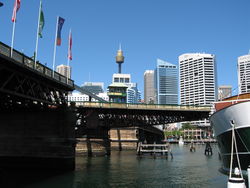
Argentina
- Puente de la Mujer, an asymmetrical cable-stayed span.
Australia
- Pyrmont Bridge, Sydney, Australia. (opened 1902. Closed to traffic, 1988. Still in use as pedestrian and monorail bridge.)
- Glebe Island Bridge, Sydney, Australia. (Opened 1901. Closed to traffic, 1995; supplanted by Anzac Bridge. Still in existence.)
- Victoria Bridge,Townsville, Queensland, Australia.(Opened 1889, closed to traffic 1975. Still in use as a foot bridge.)
- The Sale Swing Bridge, Sale, Victoria, Australia. (Opened 1883. Closed to traffic in 2002. Restored to full working order in 2006.)
- Dunalley Bridge, Dunalley, Tasmania Still in use.
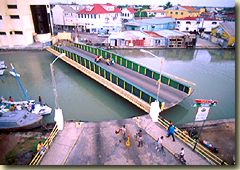
Belize
- Belize City Swing Bridge, Belize City, Belize. Oldest such bridge in Central America and the only manually operated swing bridge in world still in operation. (Restored in 2000's)
Canada
| Bridge Name | Waterway | Co-ordinates | Status | Comments |
|---|---|---|---|---|
| Canso Canal Bridge | Canso Canal, Nova Scotia | Still swings, Vehicle/Rail Traffic | Links Nova Scotia mainland with Cape Breton Island | |
| CNR Bridge | Fraser River, British Columbia | Still swings, Rail Traffic | Between Queensborough in New Westminster, British Columbia and the mainland | |
| Derwent Way Bridge | Fraser River, British Columbia | Still swings, Vehicle/Rail Traffic | Between Queensborough in New Westminster, British Columbia and Annacis Island in Delta, British Columbia | |
| Hog's Back Bridge | Rideau Canal, Ottawa, Ontario | Still swings, Vehicle Traffic | This bridge swings from one end. There is an adjacent fixed bridge over Hog's Back Falls | |
| Iron Bridge | Third Welland Canal, Thorold, Ontario | No longer swings, Rail Traffic | Carrying the CNR Grimsby Subdivision over the third Welland Canal. | |
| Kaministiquia River Swing Bridge | Kaministiquia River, Thunder Bay, Ontario | No longer swings. Road and rail traffic only | ||
| Little Current Swing Bridge | North Channel, Little Current, Ontario | Still swings, Vehicle Traffic (formerly rail) | Built by Algoma Eastern Railway, 1913 | |
| Montrose Swing Bridge | Welland River, Niagara Falls, Ontario | No longer swings, Rail Traffic | Formerly Canada Southern Railway, now CPR | |
| Moray Bridge | Middle Arm of the Fraser River, Richmond, British Columbia | Still swings; Eastbound Vehicle Traffic | Connects Sea Island, Richmond, BC (location of Vancouver International Airport) to Lulu Island, Richmond, BC | |
| New Westminster Bridge | Fraser River, British Columbia | Still swings, Rail Traffic | Between New Westminster and Surrey. | |
| Pitt River Bridge | Pitt River, British Columbia | No longer swings, Vehicle Traffic | Twin side-by-side bridges connecting Port Coquitlam, British Columbia to Pitt Meadows, British Columbia | |
| Pitt River Railway Bridge | Pitt River, British Columbia | Still swings - Rail Traffic | (Please Contribute) | |
| Wasauksing (Rose Point) Swing Bridge | South Channel, Georgian Bay, near Parry Sound, Ontario | Still swings, Vehicle Traffic (formerly rail) | Links Wasauksing First Nation (Parry Island) to the mainland at Rose Point | |
| Welland Canal, Bridge 15 | Welland Recreational Waterway, Welland, Ontario | No longer swings, Rail Traffic | Built by Canada Southern Railway, ca. 1910. Now operated by Trillium Railway | |
| Welland Canal, Bridge 20 Approach Span | 2nd and 3rd Welland Canal, Port Colborne, Ontario | No longer swings, Abandoned (formerly rail) | Abandoned 1998 when adjacent Vertical lift bridge was dismantled. | |
| unknown names | Red River, Winnipeg, Manitoba | one is abandoned. one is in use. | one in use is a rail crossing over the river |
Egypt
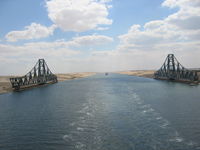
- The longest swing bridge span is 340 metres, by the El Ferdan Railway Bridge across the Suez Canal.
France
- Le pont tournant rue Dieu, across the Canal Saint-Martin in Paris, is a distinctive location in the 1938 film Hôtel du Nord, and is featured in the opening shot of the film.
Germany
- Kaiser-Wilhelm-Brücke in Wilhelmshaven, built in 1907, with the length of 159m, it was once Europe's biggest swing bridge
The Netherlands
Abtsewoudsebrug in Delft, close the Technische Universiteit Delft, is a bridge of this type.
India
- Garden Reach Road Swing Bridge, for Calcutta Port, Kidderpore, Kolkata
- Poira-Corjuem Bridge, for GSIDC, Corjuem, Goa by Rajdeep Buildcon Pvt. Ltd.
Ireland
- Samuel Beckett Bridge, Dublin, Ireland
- Seán O'Casey Bridge, Dublin, Ireland
- Michael Davitt Bridge, Co. Mayo, Ireland
- Portumna Bridge, Portumna, Co. Galway, Ireland
Italy
- Ponte Girevole, Taranto
Latvia
- Kalpaka Tilts, Liepāja, connecting the city with the former Russian/Soviet port Karosta. The bridge is temporary not operating after a ship rammed part of the construction.
New Zealand
- Kopu Bridge, Waihou River, near Thames, New Zealand
Panama
- A swing bridge at the Gatun Locks provides the only road passage over the Atlantic side of the Panama Canal.
Ukraine
- Barbara (Varvarovski) Bridge thru Southern Bug in Mykolaiv.
United Kingdom
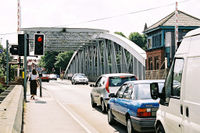

- Boothferry swing bridge at Boothferry, Yorkshire (see article for image)
- Connaught Crossing in London Docklands, built as a low-rising swing bridge to allow marine traffic in the Royal Docks to pass at a place when the proximity of London City Airport meant a higher fixed bridge was not practicable.
- Manchester Ship Canal at Latchford, Stockton Heath and Lower Walton in Warrington, and also slightly further west at Moore. Near the eastern end of the canal in Salford, the Barton Road Swing Bridge is adjacent to the Barton Swing Aqueduct - a 234-foot, 800-tonne trough holding some 800 tonnes of water (retained by gates at either end) swings so that it is at right angles to the Bridgewater Canal to allow ships to pass up the Ship Canal.
- Swing Bridge, River Tyne at Newcastle Upon Tyne. The Tyne swing bridge has an 85.7 metre cantilevered span with a central axis of rotation able to move through 90° to allow vessels to pass on either side of it.
- Trowse Bridge at Norwich. Carries the electrified Great Eastern Main Line over the River Yare. It is the only overhead electrified swing bridge in the country.
- Barmouth Bridge - rail
- Beccles swing bridge - rail
- Bethells Swing Bridge
- Goole swing bridge - rail
- Hawarden Railway Bridge - rail (now deactivated).
- Hull, England docks branch bridge - rail
- Leeds and Liverpool Canal Has a large number of swing bridges, especially between Bingley and Skipton and Burscough and Liverpool. Many are manually operated, carrying only farm tracks, but a significant number carry road traffic and are mechanised for boater operation.
- Kennet and Avon Canal at Sulhamstead, Berkshire
- Oulton Broad swing bridge - rail
- Reedham swing bridge - rail
- Selby swing bridge - rail
- Somerleyton swing bridge
- Sutton Bridge swing bridge
- Caernarfon swing bridge
- Ross Bridge, Penzance
- Kincardine Bridge - crossing the Firth of Forth from Falkirk council area to Kincardine-on-Forth, Fife
|
|
|
|
United States
The largest double swing span bridge in the United States is the 3,250 feet (990 m) long, 450 feet (140 m) navigable span, 60 feet (18 m) clearance George P. Coleman Memorial Bridge.[1]
- Bridgeport Swing Bridge, Bridgeport, Alabama (demolished in late 1970s, replaced with new span)
- Berkley-Dighton Bridge, connects the towns of Berkley, Massachusetts and Dighton crossing the Taunton River
- New Bedford-Fairhaven Bridge, Massachusetts connects the city of New Bedford and the town of Fairhaven across their shared harbor
- Ben Sawyer Bridge, Mount Pleasant, SC connects the city of Mount Pleasant with Sullivan's Island
- Blackburn Point Road bridge, over the Intracoastal Waterway in Osprey, Florida
- Bridge No. 4455, Central Avenue over Lewis Gut, Bridgeport, Connecticut (1924 steel swing bridge)
- Burlington Northern Santa Fe Railroad Bridge crossing the Columbia River, Portland, OR
- Center Street Bridge, Cleveland, Ohio (1901)
- Chef Menteur Bridge, near Slidell, Louisiana
- Columbus Drive Bridge, Tampa, Florida, a bobtail swing bridge over the Hillsborough River
- CSX Rail Bridge, Indiantown, Florida
- Curtis Creek Rail Bridge, Baltimore, Maryland
- East Haddam Bridge, Route 82 over the Connecticut River, East Haddam, Connecticut (1913)
- Fort Madison Toll Bridge, crosses Mississippi River and connects Fort Madison, Iowa with Niota, Illinois.
- Fort Pike Bridge, near Slidell, Louisiana and New Orleans, Louisiana
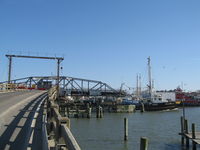
- Frederick Douglass Memorial Bridge, Washington, DC
- Figure Eight Island Bridge, North of Wilmington, North Carolina
- George P. Coleman Memorial Bridge, over the York River between Yorktown, Virginia and Gloucester Point, Virginia
- Government Bridge on the Mississippi River between Davenport, Iowa and Rock Island, Illinois (1896)
- Grand Haven GTW RR Swing Bridge Connecting Grand Haven & Ferrysburg, MI
- Grand Rapids Swing Bridge in Grand Rapids, Michigan
- Grosse Ile Toll Bridge and nearby Wayne County Bridge, Grosse Ile, Michigan
- Harmar Railroad Bridge, Marietta, Ohio
- I Street Bridge, Sacramento, California
- International Railway Bridge connecting Buffalo, New York and Fort Erie, Ontario, Canada [2]
- La Crosse Railway Bridge La Crosse Rail Bridge
- Livingston Avenue Bridge, Albany, New York
- Middle Branch of Patapsco River Rail Bridge, near Camden Yards, Baltimore, Maryland
- Mathers Bridge, Connecting Merritt Island, Florida to Indian Harbour Beach, Florida across the Banana River
- Mystic River Railroad Bridge, Mystic, Connecticut, carries Amtrak's Northeast Corridor tracks over the Mystic River.[2]
- Naples Swing Bridge, Naples, Maine, taking U.S. Route 302 across the Chute River
- New Richmond Swing Bridge, near Fennville, Michigan
- Newport Rail Bridge over the Mississippi River between Inver Grove Heights and Saint Paul Park, Minnesota
- Norfolk Southern Railway (former Conrail) Bridge crossing the Maumee River, Toledo, Ohio
- The 2,800 ft Norfolk Southern Railway Bridge crossing the Ocmulgee River in Lumber City, Georgia built 1916. "Note- Electrical Swing Components Removed"
- North Fork New River Bridge, Fort Lauderdale, Florida
- Northern Avenue Bridge over Fort Point Channel in Boston, Massachusetts (1908 steel truss)
- Padanaram Bridge on the causeway protecting Apponagansett Bay in Dartmouth, Massachusetts
- Omaha Road Bridge Number 15, an asymmetrical single track railroad bridge over the Mississippi River between Saint Paul, Minnesota and Lilydale, Minnesota (1916)
- Pennsylvania Railroad's Shellpot Branch over Christina River in Wilmington, Delaware (original two-track bridge replaced with a single track bridge in 2003)
- Pennsylvania Railroad's South Philadelphia Branch over Schuylkill River
- Portal Bridge which carries the Northeast Corridor over the Hackensack River between Kearny and Secaucus in New Jersey.
- Providence & Worcester railroad bridge, Middletown, Connecticut
- Riverside-Delanco Bridge over Rancocas Creek in New Jersey
- Victory Bridge bridge that crosses the Raritan River in Perth Amboy (taken down in 2003)
- Saugatuck River Bridge (Bridge No. 1349), Route 136 over the Saugatuck River, Westport, Connecticut (1884 iron-truss swing bridge)
- Shaw Cove Railroad Bridge, New London, Connecticut, carries Amtrak's Northeast Corridor tracks over the entrance to Shaw Cove in New London. [2]
- Snow-Reed Swing Bridge, Fort Lauderdale, Florida - crosses the New River and connects the Sailboat Bend neighborhood with the Riverside Park neighborhood.
- Spokane Street Bridge over the Duwamish Waterway in Seattle, Washington (1991 reinforced concrete double swing span)
- St. Joseph Swing Bridge over the Missouri River, St. Joseph, Missouri (1904)
- Surf City Bridge Surf City, NC
- Trail Creek Swing Bridge in Michigan City, Indiana which carries the Michigan Central Railroad now operated by Amtrak.
- Union Pacific Railroad (former CNW) Bridge crossing the Mississippi River, Clinton, Iowa
- Woods Memorial Bridge over the Beaufort River in Beaufort, SC
- Seven bridges over the Harlem River in New York City, including from south to north:
- Willis Avenue Bridge
- Third Avenue Bridge
- Madison Avenue Bridge
- 145th Street Bridge
- Macombs Dam Bridge
- University Heights Bridge
- Spuyten Duyvil Bridge
- Chincoteague Channel Swing Bridge, Chincoteague, Virginia
- In South Bristol, Maine, Rutherford Island is connected to the mainland by a short asymmentric swing bridge.
Vietnam
- Han River Bridge in Da Nang
See also
- Movable bridge for a list of other movable bridge types
References
- ↑ http://www.pbs.org/wgbh/buildingbig/wonder/structure/george_p_coleman.html
- ↑ 2.0 2.1 Amtrak Moveable Bridge Smart Card